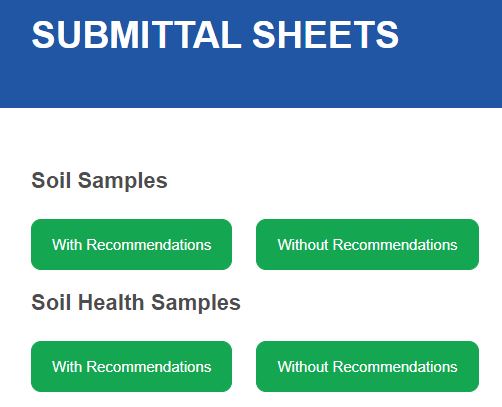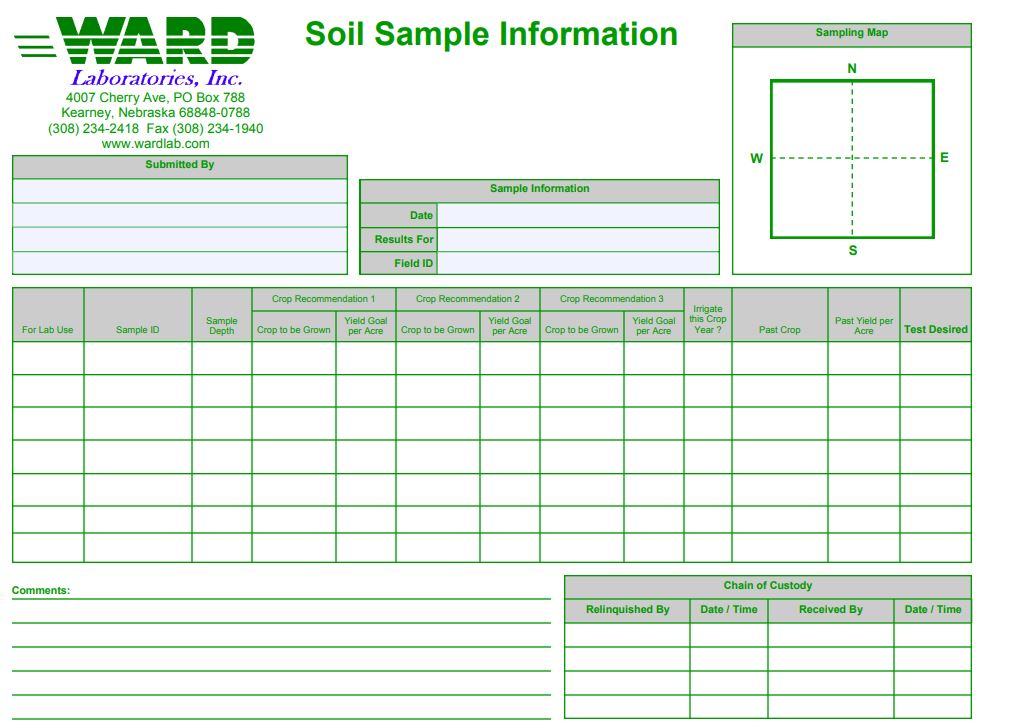Some things to keep in mind when selecting a Soil Test Lab:
1. If you aren't willing to put the effort into proper sampling, it doesn't mater what lab you use. You might as well use one of the home tests sold at Lowes, because sh@t in = sh@t out no matter how good the lab. Studies (my interpretation) have shown that 8 samples from each 3000-3500 square feet section of soil will result in a final sample that has a probability of being representative of the entire 3000 sq. ft. area 90% of the time. Each additional sample above 8, will only improve the probability by 1-2% with diminishing improvement with each additional sample. However, each fewer sample will dramatically reduce the probability that the final mix of samples will be reflective of the whole 3000 sq. ft. plot tested with 4 or fewer total samples having about a 50% or less chance of accurately reflecting the 3000 sq ft area. So if you aren't willing to put the effort in to sample correctly, it doesn't matter which lab you select. Just use a Lowes home test.
2. Most labs will do a decent job of testing and provide useful results. So, 9 out of 10 times whatever lab you chose will suffice. Soil Savvy or MySoil are not ones I would use. If you want some assurance that a lab has at least met some verifiable standards of accuracy, reliability and repeatability, select one of the labs that participate in and are NAPT/PAP certified: https://www.naptprogram.org/pap.
3. Identify which testing method you want to use. There are a number of nutrient extraction methods. This is dependent on the pH of the soil or, in some cases, an item of personal preference. I happen to be old school and prefer: ammonium acetate for the Base Cations: K, Ca, Mg (gives accurate results no mater the soil pH), Bray/Olsen/Mehlich for P (phosphorous-choice of method is very dependent on the pH of soil - use Mehlich or Bray if pH is below 7.2 and use Olsen if pH is above 7.2), and DTPA for micro-nutrients. However for most turf enthusiasts, I would recommend Mehlich3 if soil pH is below 7.2 (in higher pH soils Mehlich 3 can result in drastically inaccurate Ca and sometimes Mg levels. In higher pH soils, pH >7.2, use ammonium acetate).
Mehlich 3 is the method preferred and employed by the vast majority of turf research (university and PACE) and it will aid in simplifying comparisons and drawing conclusion between the current research and your soil results. If you wish to employ the MLSN/build/maintenance program I describe as the "Somewhat EASY, SIMPLE METHOD for Determining Fertilizer Rates and Nutrient Levels to Achieve Optimal Nutrient Levels" in my soil test thread then it isn't really critical which measuring stick/test you use as long as it's appropriate (for the pH) for your soil.
4. Look for a lab that offers a comprehensive battery of tests. Individual tests that they provide for testing for things like EC (electric conductivity-measurement of soil salinity), Buffer pH (BpH-to determine the amount of lime needed to raise pH), soil microbial health (Solvita), tissue testing or soil carbonate content testing (to determine the amount of Sulfur that would be needed to lower pH). Items that you may have a need to test for in the future.
5. Look for a lab that offers a variety test suites. Do they offer suites that including "comprehensive" testing for the Primary, secondary, and trace nutrients? Do the have a suite that includes Buffer pH? Soil Salinity? Do they offer pared down suites that only test for the primary nutrients at a reduced cost? (Although I would recommend a very comprehensive testing suite for the first test done (test primaries, secondaries, trace/micros, salinity and BpH etc. to see where your soil is at/more information makes for better decisions), after which, if your micros and secondary nutrients are within range, you don't need to test them yearly. Run that test every other or third year. Save money and only test the Primary nutrients in the intermediate years.
6. Look at the amenities the lab provides. How easy is it to access, understand and use the portal/site and forms. In addition, some labs will store your yearly results and allow you to run comparisons of individual nutrient changes from one year to the next.
7. Compare fees between labs. (cheapest isn't always best, although don't get fleeced either)
8. Once selected, use the same lab for each subsequent test. It will help reduce variability in results when you make comparisons from year to year.
Quick Summary:
1. Pick an NAPT/PAP lab.
2. Sample correctly.
3. If soil pH is below 7.2, use the Mehlich 3 method.
4. If soil pH is above 7, use the Ammonium Acetate and Olsen methods.
1. If you aren't willing to put the effort into proper sampling, it doesn't mater what lab you use. You might as well use one of the home tests sold at Lowes, because sh@t in = sh@t out no matter how good the lab. Studies (my interpretation) have shown that 8 samples from each 3000-3500 square feet section of soil will result in a final sample that has a probability of being representative of the entire 3000 sq. ft. area 90% of the time. Each additional sample above 8, will only improve the probability by 1-2% with diminishing improvement with each additional sample. However, each fewer sample will dramatically reduce the probability that the final mix of samples will be reflective of the whole 3000 sq. ft. plot tested with 4 or fewer total samples having about a 50% or less chance of accurately reflecting the 3000 sq ft area. So if you aren't willing to put the effort in to sample correctly, it doesn't matter which lab you select. Just use a Lowes home test.
2. Most labs will do a decent job of testing and provide useful results. So, 9 out of 10 times whatever lab you chose will suffice. Soil Savvy or MySoil are not ones I would use. If you want some assurance that a lab has at least met some verifiable standards of accuracy, reliability and repeatability, select one of the labs that participate in and are NAPT/PAP certified: https://www.naptprogram.org/pap.
3. Identify which testing method you want to use. There are a number of nutrient extraction methods. This is dependent on the pH of the soil or, in some cases, an item of personal preference. I happen to be old school and prefer: ammonium acetate for the Base Cations: K, Ca, Mg (gives accurate results no mater the soil pH), Bray/Olsen/Mehlich for P (phosphorous-choice of method is very dependent on the pH of soil - use Mehlich or Bray if pH is below 7.2 and use Olsen if pH is above 7.2), and DTPA for micro-nutrients. However for most turf enthusiasts, I would recommend Mehlich3 if soil pH is below 7.2 (in higher pH soils Mehlich 3 can result in drastically inaccurate Ca and sometimes Mg levels. In higher pH soils, pH >7.2, use ammonium acetate).
Mehlich 3 is the method preferred and employed by the vast majority of turf research (university and PACE) and it will aid in simplifying comparisons and drawing conclusion between the current research and your soil results. If you wish to employ the MLSN/build/maintenance program I describe as the "Somewhat EASY, SIMPLE METHOD for Determining Fertilizer Rates and Nutrient Levels to Achieve Optimal Nutrient Levels" in my soil test thread then it isn't really critical which measuring stick/test you use as long as it's appropriate (for the pH) for your soil.
4. Look for a lab that offers a comprehensive battery of tests. Individual tests that they provide for testing for things like EC (electric conductivity-measurement of soil salinity), Buffer pH (BpH-to determine the amount of lime needed to raise pH), soil microbial health (Solvita), tissue testing or soil carbonate content testing (to determine the amount of Sulfur that would be needed to lower pH). Items that you may have a need to test for in the future.
5. Look for a lab that offers a variety test suites. Do they offer suites that including "comprehensive" testing for the Primary, secondary, and trace nutrients? Do the have a suite that includes Buffer pH? Soil Salinity? Do they offer pared down suites that only test for the primary nutrients at a reduced cost? (Although I would recommend a very comprehensive testing suite for the first test done (test primaries, secondaries, trace/micros, salinity and BpH etc. to see where your soil is at/more information makes for better decisions), after which, if your micros and secondary nutrients are within range, you don't need to test them yearly. Run that test every other or third year. Save money and only test the Primary nutrients in the intermediate years.
6. Look at the amenities the lab provides. How easy is it to access, understand and use the portal/site and forms. In addition, some labs will store your yearly results and allow you to run comparisons of individual nutrient changes from one year to the next.
7. Compare fees between labs. (cheapest isn't always best, although don't get fleeced either)
8. Once selected, use the same lab for each subsequent test. It will help reduce variability in results when you make comparisons from year to year.
Quick Summary:
1. Pick an NAPT/PAP lab.
2. Sample correctly.
3. If soil pH is below 7.2, use the Mehlich 3 method.
4. If soil pH is above 7, use the Ammonium Acetate and Olsen methods.







